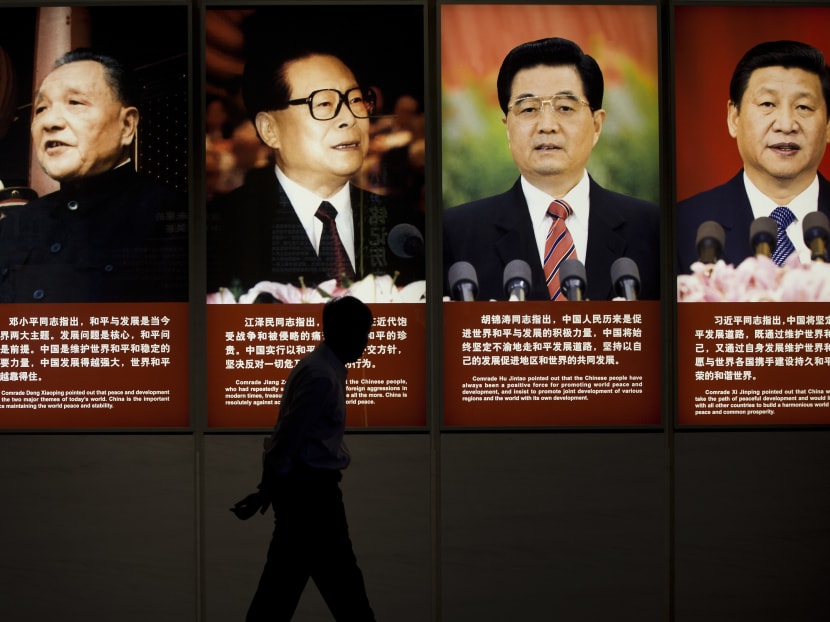Cowboy hats and Disneyland: Chinese leaders’ past US visits
BEIJING — One wore a cowboy hat. Another sang some opera and played guitar. Chinese leaders have set a colourful path for President Xi Jinping to follow on his trip to the US this week, the latest in a string of visits since formal diplomatic relations were established between Washington and Beijing in 1979. Much attention was focused on the first visit by Deng Xiaoping in 1979 and again on Mr Jiang Zemin’s nearly two decades later in 1997 — the first in a dozen years and the first since the Tiananmen crackdown. After China joined the World Trade Organization in 2001, the visits become more routine.

A man walks past the images of China's past and present leaders from left, Deng Xiaoping, Jiang Zemin, Hu Jintao and Xi Jinping on display at a museum in Beijing. One wore a cowboy hat. Another visited Disneyland and Hollywood. Photo: AP
BEIJING — One wore a cowboy hat. Another sang some opera and played guitar. Chinese leaders have set a colourful path for President Xi Jinping to follow on his trip to the US this week, the latest in a string of visits since formal diplomatic relations were established between Washington and Beijing in 1979. Much attention was focused on the first visit by Deng Xiaoping in 1979 and again on Mr Jiang Zemin’s nearly two decades later in 1997 — the first in a dozen years and the first since the Tiananmen crackdown. After China joined the World Trade Organization in 2001, the visits become more routine.
Some highlights:
DENG XIAOPING, 1979 — Deng’s groundbreaking visit came at a time when China was still clambering its way out of the 10-year disaster of the Cultural Revolution and seeking economic agreements and technology to propel its long dormant economy back into action. Along with meeting President Jimmy Carter, Deng embarked on a publicity tour to drum up business, famously donning a 10-gallon cowboy hat at a Texas rodeo. His amicable demeanor won good will from the Americans, and he received an honorary degree from Temple University.
LI XIANNIAN, 1985 — Li’s visit came amid heightened Cold War tensions when the U.S. and China found common cause opposing the Soviet occupation of Afghanistan. Along with visits to the White House and Capitol Hill, the president toured Hollywood and Disneyland and visited Chicago and Hawaii in an appeal for more trade and investment.
JIANG ZEMIN, 1997 — After a gap in visits of a dozen years and a sharp decline in relations caused by the bloody 1989 crackdown on pro-democracy demonstrations in Beijing’s Tiananmen Square, new leader Jiang brought a conciliatory stance in 1997 that helped ease frictions. One of the highlights was a speech at Harvard University, when he sought to appeal directly to the American public by speaking partly in English. To break the stereotype of stiff Chinese leaders, Mr Jiang sang some Peking opera and played Hawaii guitar at a dinner in Honolulu.
JIANG ZEMIN, 2002 — In his last year in power, Mr Jiang visited with President George W Bush at his Texas ranch before the two attended an Asia-Pacific summit in Mexico. Mr Jiang pushed hard for the US to end support for the self-governing island province of Taiwan that China claims as its own. Mr Bush sought China’s support, or at least neutrality, in its effort to force Iraqi leader Saddam Hussein from power. They chatted about Chinese basketball player Yao Ming.
HU JINTAO, 2006 — Mr Hu’s largely forgettable visit was most notable for the glitches. The sides had quarreled over what to call the trip, with the US refusing to give it the full imprimatur of a state visit. At the White House welcoming ceremony, Mr Hu was mistakenly announced as the president of the Republic of China, Taiwan’s formal name, then heckled by an activist from the Falun Gong meditation sect who had obtained a press pass. Mr Hu also told Mr Bill Gates that he used the Microsoft operating system every day.
HU JINTAO, 2011 — Mr Hu’s second visit went considerably better from the Chinese viewpoint, with full honors afforded, including a 21-gun salute. Unusually for a Chinese leader, Mr Hu attended a press conference with his host President Barack Obama, resulting in some awkward moments when he was queried about China’s human rights record. Mr Hu replied that “a lot still needs to be done,” damaging his standing among Chinese nationalists who see the human rights agenda as a Western plot to undermine China’s rise as a global power. AP






